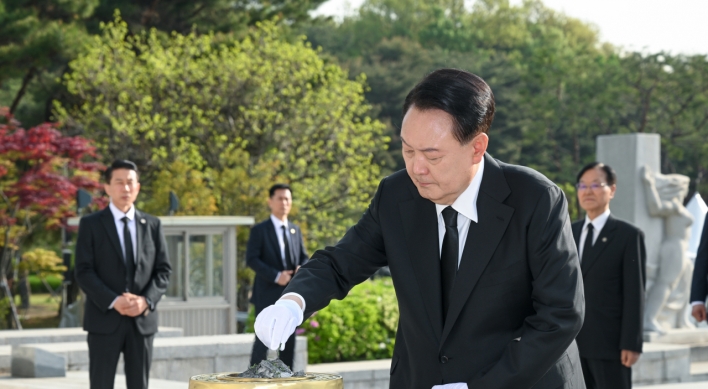
American artist Maya Lin wears many hats. She is an installation artist, sculptor, architect and sometimes an environmental activist. Visually beautiful, her works engage in dialogue and hold value in nature.
Recent works by the globally acclaimed artist were unveiled at Pace Gallery in Seoul's “Nature Knows No Boundaries” exhibition, running through March 11, inviting viewers to reflect on the history of the Korean Peninsula as well as how climate change is eroding the globe.
For her first ever show in Seoul, Lin highlighted the rivers that flow through the two Koreas -- the Han River and the Imjin River. “Pin Gang – Imjin and Han,” created with her signature stainless steel pins, evolved from a question: What flows North to South naturally?

“Water has been a very strong inspiration and material element of most of my works. It forms the heart of the works that are all about rivers and waterways around the gallery,” the artist said at the artist talk held Wednesday at Hongik University, Seoul.
Another work, “Marble Han River Dam” shows the waterline of Seoul’s Han River created with glass marbles. The artist talked about how she was exposed to glass marbles at an early age when her father brought home a box of industrial glass marbles.

“I remember playing with them, and I think I am still playing with them,” she said. Another installation of her glasswork is “Dew Point 8” on the floor of the gallery, created with blown glass.
She has been “obsessed,” Lin said, with the Arctic and Antarctic, and has been keen on showing how ice is gradually disappearing in the two regions due to climate change. She added that the world is not just losing the area of the ice, but also its thickness. Her work “White Fracture,” created in 1994, is one of her works to raise awareness of the impact of climate change.
Lin said sometimes she considers herself a cartographer as she maps aspects of the natural world shifting under our feet.
“We (humans) are very visual and if we can’t see it -- we just do not even realize it is there, and a lot of my art has tried to reveal aspects on the natural world that you might not be thinking about,” the artist said, reminding the audience that almost 80 percent of the globe is covered by ocean.

“Silver Tigris & Euphrates Watershed” is a new work created with recycled silver. “I choose rivers because they are just so critically important. Tigris-Euphrates river is almost the dawn of human civilization. It is sort of the beginning of civilization as we know it today. They are very important historically and ecologically,” Lin said.
Lin used recycled silver to create the rivers in "Silver Tigris & Euphrates Watershed," inspired by the expression "running silver." The expression was coined by European settlers in the Americas who were struck by the silvery light reflecting off the backs of fish in rivers, so abundant were the fish.
Lin became internationally known for the Vietnam Veterans Memorial in Washington built in 1982. She had won the nationwide design competition at just 21, while still an undergraduate at Yale University. Her recent architecture designs include the redesign of the Neilson Library at Smith College, completed in 2021.
Lin was awarded the Presidential Medal of Freedom, the nation’s highest civilian honor, in 2016 from then-President Barack Obama. She has been commissioned to create public artwork in the Obama Presidential Center, which is now under construction in Chicago.
By Park Yuna (yunapark@heraldcorp.com)







![[KH Explains] Hyundai's full hybrid edge to pay off amid slow transition to pure EVs](http://res.heraldm.com/phpwas/restmb_idxmake.php?idx=644&simg=/content/image/2024/04/18/20240418050645_0.jpg&u=20240419100350)







![[From the Scene] Monks, Buddhists hail return of remains of Buddhas](http://res.heraldm.com/phpwas/restmb_idxmake.php?idx=652&simg=/content/image/2024/04/19/20240419050617_0.jpg&u=20240419175937)

![[KH Explains] Hyundai's full hybrid edge to pay off amid slow transition to pure EVs](http://res.heraldm.com/phpwas/restmb_idxmake.php?idx=652&simg=/content/image/2024/04/18/20240418050645_0.jpg&u=20240419100350)

![[Today’s K-pop] Illit drops debut single remix](http://res.heraldm.com/phpwas/restmb_idxmake.php?idx=642&simg=/content/image/2024/04/19/20240419050612_0.jpg&u=)